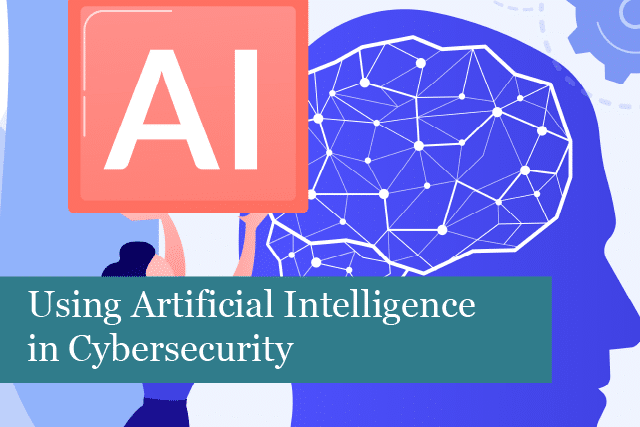
Businesses of all sizes continue to be hit by massive cyberattacks, which are continuing to grow in number and rapidly evolve. No matter the type of business you run, hackers and other bad actors are out to try to get access to your network and company data. At any one time, your company could be facing up to many different attacks, which must be analysed to accurately assess their level of risk.
For these reasons, it’s essential to improve cybersecurity. It’s past time for solely human interventions. AI (artificial intelligence) is fast becoming a tool used for cybersecurity to help IT teams reduce risks and improve their company’s security effectively and efficiently.
AI and machine learning (ML) create a powerful combination of technologies in IT security. They’re able to quickly analyse millions of events and identify many different types of threats. What’s more, these technologies learn over time, drawing on past experience to identify new types of attacks. These technologies learn through histories of behaviour by building profiles on users, assets, and networks. AI can then respond quickly to any deviations from the norm.
Artificial Intelligence vs Data Analytics
As with other technologies, some confusion has developed on the differences between AI and data analytics. Data analytics use technology to analyse data and let the results drive specific outcomes. This is not AI. AI is more about reproducing general intelligence to automate tasks.
Here are the main differences between AI and data analytics:
- Artificial intelligence: AI systems are iterative and dynamic; they become smarter with the more data they analyse. They have the ability to learn from experience, and they become more capable and independent as they learn more.
- Data analytics: is a static process that examines large amounts of data sets in order to determine conclusions about the information. They use specialised systems and software for this work. Data analytics is not iterative or self-learning. The technology is not autonomous.
Understanding the Basics of Artificial Intelligence
AI refers to technologies that have the ability to understand, learn, and act based on acquired and derived information. AI works in the following ways:
- Assisted intelligence: currently in use; improves what humans and organisations are already doing (processes and more)
- Augmented intelligence: emerging tech; that makes it possible for people and companies to do things they would not be able to do otherwise.
- Autonomous intelligence: for the future; features machines that act on their own. For instance, self-driving vehicles (when they gain more widespread use).
It’s said that AI has some degree of human intelligence. It’s store-specific knowledge and uses mechanisms to acquire new knowledge; mechanisms then put this knowledge to use. Machine learning, expert systems, neural networks, and deep learning are all examples or subsets of AI technology as it exists today.
How Does AI Work with Cybersecurity?
AI is definitely suited to working in cybersecurity. It has the ability to keep up with cybercriminals who continue to refine and expand their methods for new cyberattacks across a wide range of devices. AI works to automate threat detection and respond more efficiently than traditional software-driven solutions.
Cybersecurity does present some unique challenges:
- The vast number of organisations that can fall victim to cyber crimes
- More organisations are investing in a larger number of mobile devices
- Hundreds of attack vectors
- Major shortfalls in the number of skilled security professionals
- Masses of data have moved beyond the ability of humans to deal with
An AI-based cybersecurity, self-learning system should have the ability to solve many of these and developing cyber challenges. Technologies exist now that could properly train an autonomous system to continuously and independently gather data from across a company’s information systems. The AI can then analyse the data and use it to perform correlation patterns across millions to billions of signals relevant to cyberattack threats.
For these reasons, AI is becoming an essential tool across many areas of cybersecurity, including:
IT asset inventory: offers a complete, accurate inventory of all devices, users, and applications with access to information systems.
Threat exposure: hackers stay up to date on trends, so what’s fashionable in hacker circles changes on a regular basis. AI-based cybersecurity systems offer up-to-date knowledge of global and industry-specific threats to help prioritise crucial decisions based not only on what may attack a company but also based on the likely threats it faces.
Controls effectiveness: it’s necessary to understand the impact of various security tools and security processes being used within the company to maintain a strong security position. AI helps understand if your cybersecurity program is strong and where it may have gaps.
Breach risk prediction: because AI can oversee IT asset inventory, assess threat exposure, and control effectiveness, these systems can predict how and where your company may be breached in the future. AI can help you plan resource and tool allocation toward these weak areas. In addition, AI analysis can help you configure and enhance controls and processes to reduce your company’s risk of a cyberattack.
Incident response: AI systems can also provide improved context for prioritisation and response to security alerts, fast response to incidents, and finding root causes in order to fix vulnerabilities and avoid future problems.
Understandable explanations: another benefit of AI for cybersecurity is that these systems provide an easy-to-understand explanation of recommendations and analysis. These more explanatory statements are much easier for stakeholders to gain insights into the impact of various cyber threats and to report relevant information to all stakeholders, including end users, security operations, CISO, auditors, CIO, CEO, and board of directors.
AI Use by Cybercriminals
AI and machine learning (ML) can be used by IT professionals; however, criminals are also finding ways to implement AI for attacks. As the technology matures and becomes an integral part of cybersecurity, organisations will need to protect themselves against the potential issues that could make AI a hacker’s preferred tool.
Some downsides of AI include:
- ML and AI can help protect against cyber threats; however, hackers can attack security algorithms by targeting the data they train on, as well as the warning flags they search for.
- Hackers can also use AI to break through defences and create mutating malware that changes its structure to avoid detection.
- Without immense amounts of data and events, AI can deliver inaccurate results and false positives.
- If data manipulation goes undetected, organisations will struggle to recover the correct data that feeds their AI system, possibly leading to dangerous consequences.
Summing It Up
AI has burst onto the scene as the technology has become more useful at supplementing human IT security teams. AI offers another layer of analysis and threat identification that’s no longer possible solely for humans to manage.
An AI system offers some downsides; however, with the proper management and data, these systems are capable of driving cybersecurity solutions that can make your company stronger.
Recommended Posts

Is There a Difference Between Managed IT and IT Support?
13th June 2025


